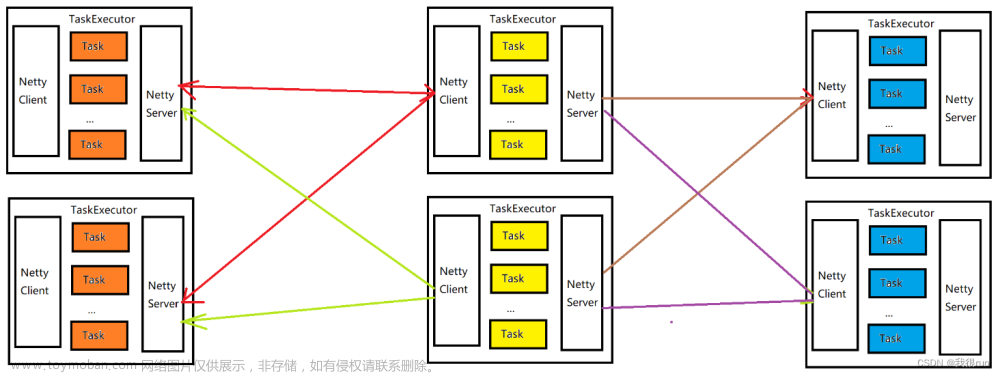IntervalJoin基于connect实现,期间会生成对应的IntervalJoinOperator。
@PublicEvolving
public <OUT> SingleOutputStreamOperator<OUT> process(
ProcessJoinFunction<IN1, IN2, OUT> processJoinFunction,
TypeInformation<OUT> outputType) {
Preconditions.checkNotNull(processJoinFunction);
Preconditions.checkNotNull(outputType);
// 检查用户自定义Function
final ProcessJoinFunction<IN1, IN2, OUT> cleanedUdf = left.getExecutionEnvironment().clean(processJoinFunction);
// 构建IntervalJoin对应的IntervalJoinOperator
final IntervalJoinOperator<KEY, IN1, IN2, OUT> operator =
new IntervalJoinOperator<>(
lowerBound,
upperBound,
lowerBoundInclusive,
upperBoundInclusive,
left.getType().createSerializer(left.getExecutionConfig()),
right.getType().createSerializer(right.getExecutionConfig()),
cleanedUdf
);
// (基于connect实现)使用给定的自定义Function,对每个元素进行连接操作
return left
.connect(right)
// 根据k1、k2,为s1、s2分配k,实际就是构建ConnectedStreams,以便后续构建IntervalJoinOperator对应的Transformation
.keyBy(keySelector1, keySelector2)
// 构建IntervalJoinOperator对应的TwoInputTransformation
.transform("Interval Join", outputType, operator);
}
并且会根据给定的自定义Function构建出对应的TwoInputTransformation,以便能够参与Transformation树的构建。
/**
* 创建StreamOperator对应的Transformation,以便能参与Transformation树的构建
*/
@PublicEvolving
public <R> SingleOutputStreamOperator<R> transform(String functionName,
TypeInformation<R> outTypeInfo,
TwoInputStreamOperator<IN1, IN2, R> operator) {
inputStream1.getType();
inputStream2.getType();
// 创建IntervalJoinOperator对应的TwoInputTransformation
TwoInputTransformation<IN1, IN2, R> transform = new TwoInputTransformation<>(
inputStream1.getTransformation(),
inputStream2.getTransformation(),
functionName,
operator,
outTypeInfo,
environment.getParallelism());
if (inputStream1 instanceof KeyedStream && inputStream2 instanceof KeyedStream) {
KeyedStream<IN1, ?> keyedInput1 = (KeyedStream<IN1, ?>) inputStream1;
KeyedStream<IN2, ?> keyedInput2 = (KeyedStream<IN2, ?>) inputStream2;
TypeInformation<?> keyType1 = keyedInput1.getKeyType();
TypeInformation<?> keyType2 = keyedInput2.getKeyType();
if (!(keyType1.canEqual(keyType2) && keyType1.equals(keyType2))) {
throw new UnsupportedOperationException("Key types if input KeyedStreams " +
"don't match: " + keyType1 + " and " + keyType2 + ".");
}
transform.setStateKeySelectors(keyedInput1.getKeySelector(), keyedInput2.getKeySelector());
transform.setStateKeyType(keyType1);
}
@SuppressWarnings({ "unchecked", "rawtypes" })
SingleOutputStreamOperator<R> returnStream = new SingleOutputStreamOperator(environment, transform);
// 将IntervalJoinOperator对应的TwoInputTransformation,添加到Transformation树上
getExecutionEnvironment().addOperator(transform);
return returnStream;
}
作为ConnectedStreams,一旦left or right流中的StreamRecord抵达,就会被及时处理:
@Override
public void processElement1(StreamRecord<T1> record) throws Exception {
/**处理left*/
processElement(record, leftBuffer, rightBuffer, lowerBound, upperBound, true);
}
@Override
public void processElement2(StreamRecord<T2> record) throws Exception {
/**处理right*/
processElement(record, rightBuffer, leftBuffer, -upperBound, -lowerBound, false);
}
两者的处理逻辑是相同的:
/**
* 处理Left和Right中的数据
*/
@SuppressWarnings("unchecked")
private <THIS, OTHER> void processElement(
final StreamRecord<THIS> record,
final MapState<Long, List<IntervalJoinOperator.BufferEntry<THIS>>> ourBuffer,
final MapState<Long, List<IntervalJoinOperator.BufferEntry<OTHER>>> otherBuffer,
final long relativeLowerBound,
final long relativeUpperBound,
// 当前Join上的数据是否为left
final boolean isLeft) throws Exception {
// 当前left or right的StreamRecord
final THIS ourValue = record.getValue();
// 当前left or right的StreamRecord中的时间戳
final long ourTimestamp = record.getTimestamp();
if (ourTimestamp == Long.MIN_VALUE) {
throw new FlinkException("Long.MIN_VALUE timestamp: Elements used in " +
"interval stream joins need to have timestamps meaningful timestamps.");
}
// 是否迟到:当前StreamRecord中的时间戳是否小于当前Watermark
if (isLate(ourTimestamp)) {
return;
}
// 将当前StreamRecord写入到它所对应的“己方MapState”中(left归left,right归right)
addToBuffer(ourBuffer, ourValue, ourTimestamp);
/**
* 遍历当前StreamRecord的“对方MapState”,判断哪个StreamRecord被Join上了
*/
for (Map.Entry<Long, List<BufferEntry<OTHER>>> bucket: otherBuffer.entries()) {
// “对方MapState”中的Key,即时间戳
final long timestamp = bucket.getKey();
// 如果遍历到的MapState的这个元素的时间戳不在(以当前StreamRecord的时间戳为基准的)Join的范围内,
// 说明没Join上,那就跳过本次循环。这是判断哪个StreamRecord是否Join上的核心!
if (timestamp < ourTimestamp + relativeLowerBound ||
timestamp > ourTimestamp + relativeUpperBound) {
continue;
}
// 反之,说明已经Join上了,那就取出这个元素的Value,即时间戳所对应的List<BufferEntry<T1>>
for (BufferEntry<OTHER> entry: bucket.getValue()) {
// 将Join上的left和right分发下游(回调用户自定义函数中的processElement()方法)
if (isLeft) {
collect((T1) ourValue, (T2) entry.element, ourTimestamp, timestamp);
} else {
collect((T1) entry.element, (T2) ourValue, timestamp, ourTimestamp);
}
}
}
// 经历双层for循环并分发下游后,计算清理时间(当前StreamRecord的时间戳+上界值)
long cleanupTime = (relativeUpperBound > 0L) ? ourTimestamp + relativeUpperBound : ourTimestamp;
// 注册Timer来清理保存在MapState中的过期数据
if (isLeft) {
internalTimerService.registerEventTimeTimer(CLEANUP_NAMESPACE_LEFT, cleanupTime);
} else {
internalTimerService.registerEventTimeTimer(CLEANUP_NAMESPACE_RIGHT, cleanupTime);
}
}
先取出当前StreamRecord中的Timestamp检查它是否已经迟到了,判断依据为:当前StreamRecord中的Timestamp是否小于当前Watermark。
/**
* 判断当前StreamRecord是否迟到:当前StreamRecord中的时间戳是否小于当前Watermark
*/
private boolean isLate(long timestamp) {
// 获取当前的Watermark
long currentWatermark = internalTimerService.currentWatermark();
// 迟到判定条件
return currentWatermark != Long.MIN_VALUE && timestamp < currentWatermark;
}
接着将当前StreamRecord写入到对应的MapState中。需要注意的是,left和right都有各自的MapState,这个MapState将Timestamp作为Key,将List集合作为Value(考虑到同一时刻可能会有多条数据)
/**
* 将当前StreamRecord写入到它所对应的MapState中(left归left,right归right)
*/
private static <T> void addToBuffer(
final MapState<Long, List<IntervalJoinOperator.BufferEntry<T>>> buffer,
final T value,
final long timestamp) throws Exception {
// 先拿着时间戳作为key去MapState中取
List<BufferEntry<T>> elemsInBucket = buffer.get(timestamp);
if (elemsInBucket == null) {
elemsInBucket = new ArrayList<>();
}
// 将StreamRecord包装成BufferEntry(默认未被Join上),add到List集合中
elemsInBucket.add(new BufferEntry<>(value, false));
// 将List集合put到MapState中(时间戳作为Key)
buffer.put(timestamp, elemsInBucket);
}
接着会经历嵌套for循环,判断哪些StreamRecord是满足Join条件的:以当前StreamRecord的Timestamp和指定的上、下界组成时间过滤条件,对当前StreamRecord的“对方MapState”内的每个Timestamp(作为Key)进行比对。
/**
* 遍历当前StreamRecord的“对方MapState”,判断哪个StreamRecord被Join上了
*/
for (Map.Entry<Long, List<BufferEntry<OTHER>>> bucket: otherBuffer.entries()) {
// “对方MapState”中的Key,即时间戳
final long timestamp = bucket.getKey();
// 如果遍历到的MapState的这个元素的时间戳不在(以当前StreamRecord的时间戳为基准的)Join的范围内,
// 说明没Join上,那就跳过本次循环。这是判断哪个StreamRecord是否Join上的核心!
if (timestamp < ourTimestamp + relativeLowerBound ||
timestamp > ourTimestamp + relativeUpperBound) {
continue;
}
// 反之,说明已经Join上了,那就取出这个元素的Value,即时间戳所对应的List<BufferEntry<T1>>
for (BufferEntry<OTHER> entry: bucket.getValue()) {
// 将Join上的left和right分发下游(回调用户自定义函数中的processElement()方法)
if (isLeft) {
collect((T1) ourValue, (T2) entry.element, ourTimestamp, timestamp);
} else {
collect((T1) entry.element, (T2) ourValue, timestamp, ourTimestamp);
}
}
}
一旦某个Key符合时间过滤条件,那就将它所对应的List集合(作为Value)取出来,逐条将其发送给下游,本质就是将其交给自定义Function处理
/**
* 将满足IntervalJoin条件的StreamRecord发送给下游,本质就是将其交给自定义Function处理
*/
private void collect(T1 left, T2 right, long leftTimestamp, long rightTimestamp) throws Exception {
final long resultTimestamp = Math.max(leftTimestamp, rightTimestamp);
collector.setAbsoluteTimestamp(resultTimestamp);
context.updateTimestamps(leftTimestamp, rightTimestamp, resultTimestamp);
// 将Join上的StreamRecord交给自定义Function,执行开发者的处理逻辑
userFunction.processElement(left, right, context, collector);
}
整个过滤筛选过程,也是IntervalJoin的核心所在!
最后,会计算保存在MapState中的StreamRecord的过期清理时间,因为StreamRecord不能一直被保存。本质就是基于InternalTimerService注册Timer,触发时间为:当前StreamRecord的Timestamp + 给定的上界值。文章来源:https://www.toymoban.com/news/detail-664464.html
// 经历双层for循环并分发下游后,计算清理时间(当前StreamRecord的时间戳+上界值)
long cleanupTime = (relativeUpperBound > 0L) ? ourTimestamp + relativeUpperBound : ourTimestamp;
// 注册Timer来清理保存在MapState中的过期数据
if (isLeft) {
internalTimerService.registerEventTimeTimer(CLEANUP_NAMESPACE_LEFT, cleanupTime);
} else {
internalTimerService.registerEventTimeTimer(CLEANUP_NAMESPACE_RIGHT, cleanupTime);
}
由于IntervalJoinOperator实现了Triggerable接口,因此一旦注册的Timer被触发,就会将对应MapState中对应的Timestamp进行remove文章来源地址https://www.toymoban.com/news/detail-664464.html
/**
* 基于InternalTimerService注册的Timer,会定时对MapState执行clean操作
*/
@Override
public void onEventTime(InternalTimer<K, String> timer) throws Exception {
long timerTimestamp = timer.getTimestamp();
String namespace = timer.getNamespace();
logger.trace("onEventTime @ {}", timerTimestamp);
switch (namespace) {
case CLEANUP_NAMESPACE_LEFT: {
long timestamp = (upperBound <= 0L) ? timerTimestamp : timerTimestamp - upperBound;
logger.trace("Removing from left buffer @ {}", timestamp);
// clean left
leftBuffer.remove(timestamp);
break;
}
case CLEANUP_NAMESPACE_RIGHT: {
long timestamp = (lowerBound <= 0L) ? timerTimestamp + lowerBound : timerTimestamp;
logger.trace("Removing from right buffer @ {}", timestamp);
// clean right
rightBuffer.remove(timestamp);
break;
}
default:
throw new RuntimeException("Invalid namespace " + namespace);
}
}
到了这里,关于深入理解Flink IntervalJoin源码的文章就介绍完了。如果您还想了解更多内容,请在右上角搜索TOY模板网以前的文章或继续浏览下面的相关文章,希望大家以后多多支持TOY模板网!











